3.多线程学习笔记之共享模型之管程
Posted 野生java研究僧
tags:
篇首语:本文由小常识网(cha138.com)小编为大家整理,主要介绍了3.多线程学习笔记之共享模型之管程相关的知识,希望对你有一定的参考价值。
文章目录
- 3.1.线程共享变量问题分析
- 3.2.synchronized 解决方案
- 3.3.方法上的synchronized
- 3.4.线程八锁
- 3.5.变量的线程安全分析
- 3.6.Monitor 概念
- 3.7.monitor原理
- 3.8.synchronized 原理进阶
- 3.9.wait notify
- 3.10 .同步模式-保护性暂停
- 3.11.异步模式-消费者/生产者模式
- 3.12.park&unpark
- 3.13.线程状态转换
- 3.13.1 NEW --> RUNNABLE
- 3.13.2 RUNNABLE <--> WAITING
- 3.13.3RUNNABLE <--> WAITING
- 3.13.4RUNNABLE <--> WAITING
- 3.13.5 RUNNABLE <--> TIMED_WAITING
- 3.13.6 RUNNABLE <--> TIMED_WAITING
- 3.13.7 RUNNABLE <--> TIMED_WAITING
- 3.13.8 RUNNABLE <--> TIMED_WAITING
- 3.13.9 RUNNABLE <--> BLOCKED
- 3.13.10 RUNNABLE <--> TERMINATED
- 3.14. 多把锁
- 3.15 线程活跃性
- 3.16 ReentrantLock
- 3.17.同步模式-顺序控制
- 3.18本章小结
3.1.线程共享变量问题分析
两个线程对初始值为 0 的静态变量一个做自增,一个做自减,各做 5000 次,结果是 0 吗?
static int counter = 0;
public static void main(String[] args) throws InterruptedException
Thread t1 = new Thread(() ->
for (int i = 0; i < 5000; i++)
counter++;
, "t1");
Thread t2 = new Thread(() ->
for (int i = 0; i < 5000; i++)
counter--;
, "t2");
t1.start();
t2.start();
t1.join();
t2.join();
log.debug("",counter);
问题分析
以上的结果可能是正数、负数、零。为什么呢?因为 Java 中对静态变量的自增,自减并不是原子操作,要彻底理 解,必须从字节码来进行分析
例如对于 i++ 而言(i 为静态变量),实际会产生如下的 JVM 字节码指令:
getstatic i // 获取静态变量i的值
iconst_1 // 准备常量1
iadd // 自增
putstatic i // 将修改后的值存入静态变量i
而对应 i-- 也是类似:
getstatic i // 获取静态变量i的值
iconst_1 // 准备常量1
isub // 自减
putstatic i // 将修改后的值存入静态变量i
而 Java 的内存模型如下,完成静态变量的自增,自减需要在主存和工作内存中进行数据交换:
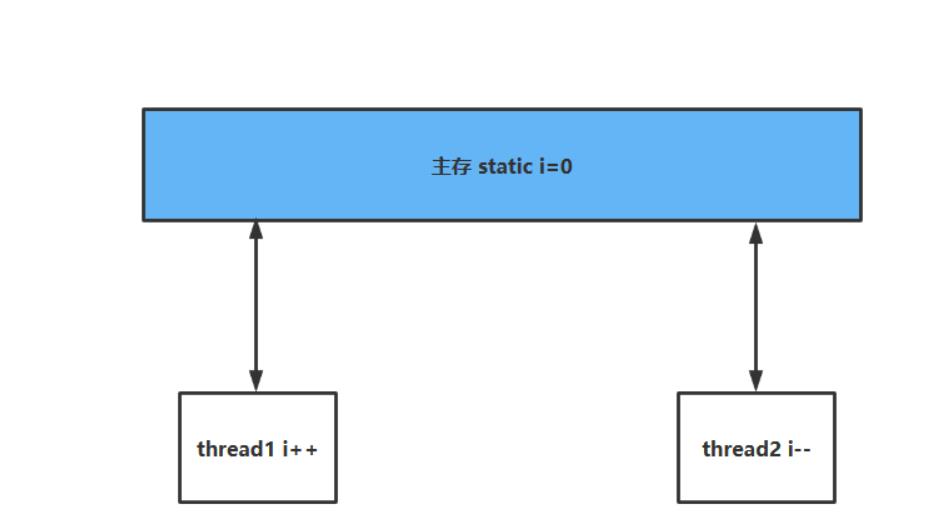
如果是单线程以上 8 行代码是顺序执行(不会交错)没有问题:
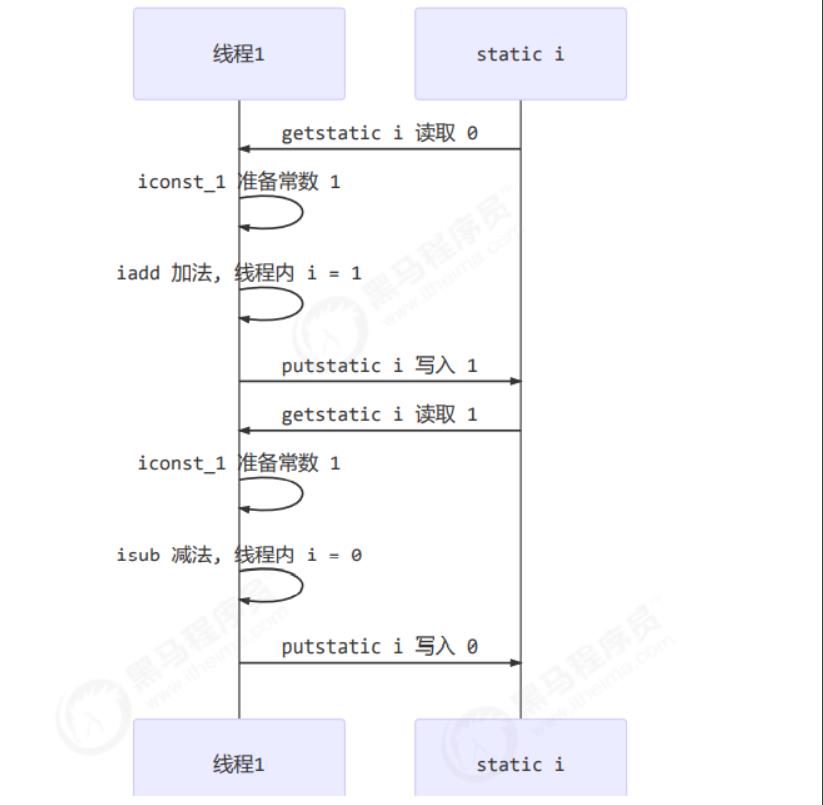
多线程情况下出现负数的情况:
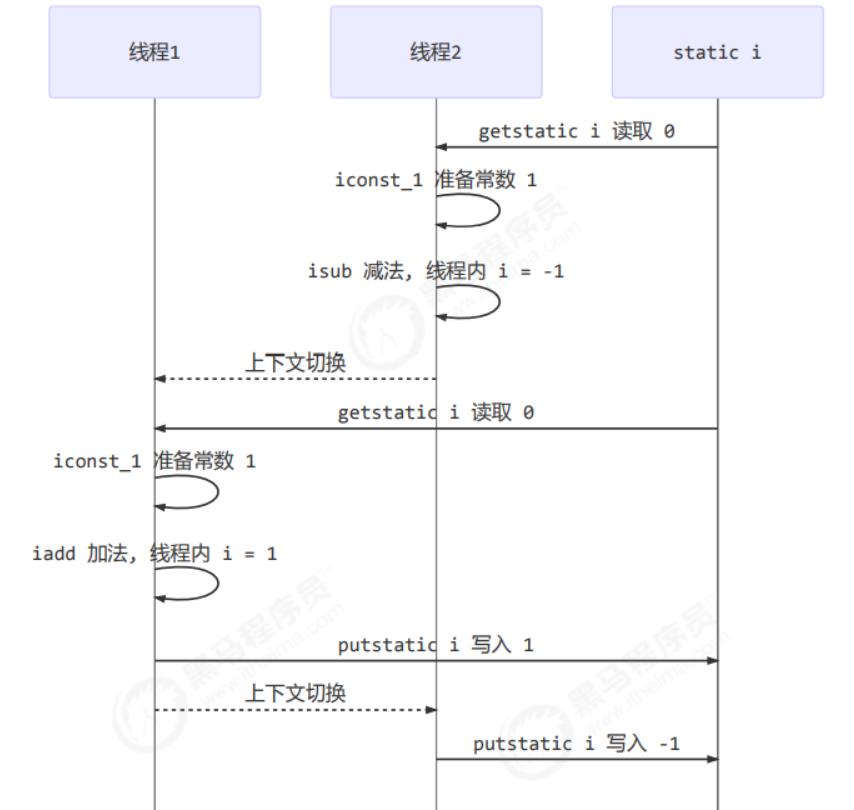
多线程情况下出现正数的情况:
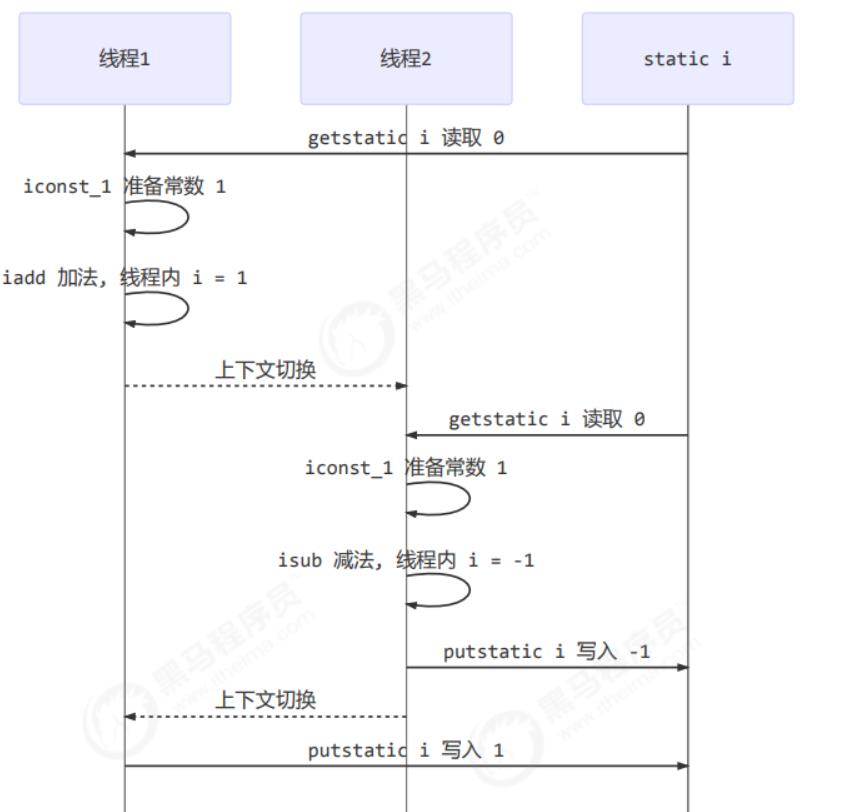
临界区 Critical Section
-
一个程序运行多个线程本身是没有问题的
-
问题出在多个线程访问共享资源
-
多个线程读共享资源其实也没有问题
-
在多个线程对共享资源读写操作时发生指令交错,就会出现问题
-
-
一段代码块内如果存在对共享资源的多线程读写操作,称这段代码块为临界区
例如,下面代码中的临界区
static int counter = 0;
static void increment()
// 临界区
counter++;
static void decrement()
// 临界区
counter--;
竞态条件 Race Condition
多个线程在临界区内执行,由于代码的执行序列不同而导致结果无法预测,称之为发生了竞态条件
3.2.synchronized 解决方案
应用之互斥
为了避免临界区的竞态条件发生,有多种手段可以达到目的。
-
阻塞式的解决方案:synchronized,Lock
-
非阻塞式的解决方案:原子变量 本次课使用阻塞式的解决方案:synchronized,来解决上述问题,即俗称的【对象锁】,它采用互斥的方式让同一 时刻至多只有一个线程能持有【对象锁】,其它线程再想获取这个【对象锁】时就会阻塞住。这样就能保证拥有锁 的线程可以安全的执行临界区内的代码,不用担心线程上下文切换
注意
虽然 java 中互斥和同步都可以采用 synchronized 关键字来完成,但它们还是有区别的:
互斥是保证临界区的竞态条件发生,同一时刻只能有一个线程执行临界区代码
同步是由于线程执行的先后、顺序不同、需要
一个线程等待其它线程运行到某个点
synchronized 语法
synchronized(对象) // 线程1, 线程2(blocked)
临界区
使用synchronized解决上面代码数据共享安全问题:
@Slf4j
public class Test1
static int counter = 0;
public static void main(String[] args) throws InterruptedException
Thread t1 = new Thread(() ->
for (int i = 0; i < 5000; i++)
// 不要错误理解为锁住了对象就能一直执行下去
synchronized (Test1.class)
counter++;
, "t1");
Thread t2 = new Thread(() ->
for (int i = 0; i < 5000; i++)
synchronized (Test1.class)
counter--;
, "t2");
t1.start();
t2.start();
t1.join();
t2.join();
log.debug("",counter);
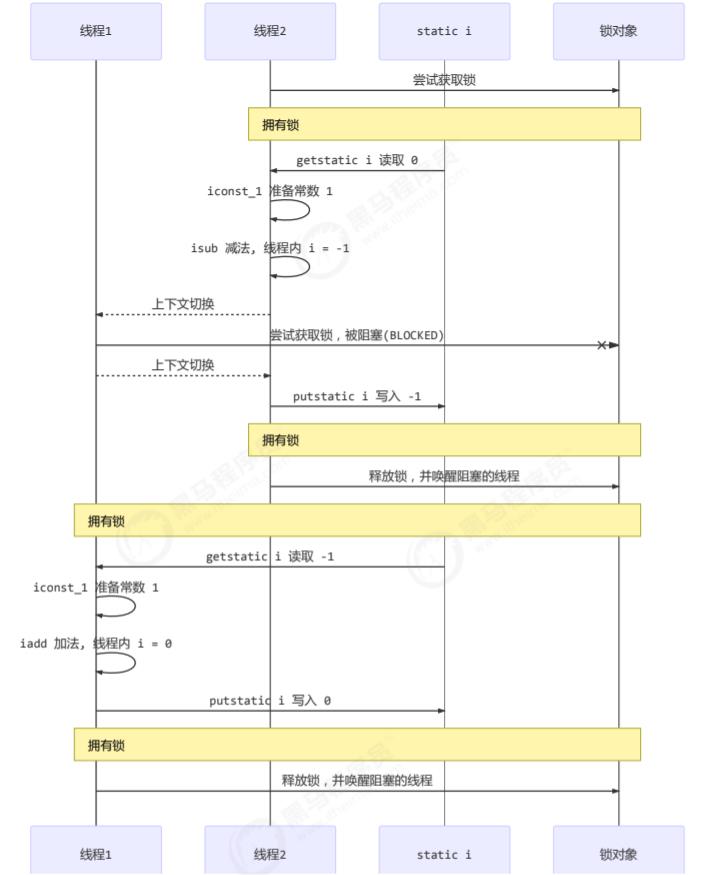
思考
synchronized 实际是用对象锁保证了临界区内代码的原子性,临界区内的代码对外是不可分割的,不会被线程切 换所打断。 为了加深理解,请思考下面的问题
- 如果把 synchronized(obj) 放在 for 循环的外面,如何理解? for循环不执行完,对象锁不会释放,其他线程无法访问
- 原子性 如果 t1 synchronized(obj1) 而 t2 synchronized(obj2) 会怎样运作? 锁的对象不一致,无法保证原子性
- 锁对象 如果 t1 synchronized(obj) 而 t2 没有加会怎么样?如何理解? t2不会获取对象锁,不会进行阻塞,照常执行
使用面向对象思想进行改进:
public static void main(String[] args) throws InterruptedException
Room room = new Room();
Thread t1 = new Thread(() ->
for (int i = 0; i < 5000; i++)
room.increment();
, "t1");
Thread t2 = new Thread(() ->
for (int i = 0; i < 5000; i++)
room.decrement();
, "t2");
t1.start();
t2.start();
t1.join();
t2.join();
log.debug("",room.get());
-------------------------------------------------------------------------------------------------------------------
public class Room
int value = 0;
public void increment()
synchronized (this)
value++;
public void decrement()
synchronized (this)
value--;
public int get()
synchronized (this)
return value;
3.3.方法上的synchronized
成员方法上: 锁 this
class Test
public synchronized void test()
//等价于
class Test
public void test()
synchronized(this)
静态方法上:锁当前类的Class对象
class Test
public synchronized static void test()
//等价于
class Test
public static void test()
synchronized(Test.class)
不加synchronized的方法,无需获取对象锁,异步执行,不能保证原子性
3.4.线程八锁
其实就是考察 synchronized 锁住的是哪个对象,是否是锁的同一个对象
以下的情况都要考虑是那个线程先抢到cpu执行权
情况1:输出:12或21
class Number
public synchronized void a()
log.debug("1");
public synchronized void b()
log.debug("2");
public static void main(String[] args)
Number n1 = new Number();
new Thread(()-> n1.a(); ).start();
new Thread(()-> n1.b(); ).start();
情况2:1秒后 12 或 2 1秒后1
class Number
public synchronized void a()
sleep(1);
log.debug("1");
public synchronized void b()
log.debug("2");
public static void main(String[] args)
Number n1 = new Number();
new Thread(()-> n1.a(); ).start();
new Thread(()-> n1.b(); ).start();
// 锁住的都是this,需要进行同步等待,就看谁先获取到cpu执行权
情况3:输出:3 1秒后12 或 23 1秒后 1 或 32 1秒后 1
class Number
public synchronized void a()
sleep(1);
log.debug("1");
public synchronized void b()
log.debug("2");
public void c()
log.debug("3");
public static void main(String[] args)
Number n1 = new Number();
new Thread(()-> n1.a(); ).start();
new Thread(()-> n1.b(); ).start();
new Thread(()-> n1.c(); ).start();
// n1.a();和n1.b();锁的都是 this对象,n1.c();未加锁无需进行同步等待
情况4:输出:2 1秒后 1
class Number
public synchronized void a()
sleep(1);
log.debug("1");
public synchronized void b()
log.debug("2");
public static void main(String[] args)
Number n1 = new Number();
Number n2 = new Number();
new Thread(()-> n1.a(); ).start();
new Thread(()-> n2.b(); ).start();
// 锁的不是同一个对象,不会产生互斥
情况5:输出:2 1秒后 1
class Number
public static synchronized void a()
sleep(1);
log.debug("1");
public synchronized void b()
log.debug("2");
public static void main(String[] args)
Number n1 = new Number();
new Thread(()-> n1.a(); ).start();
new Thread(()-> n1.b(); ).start();
// 锁的不是同一个对象,不会产生互斥,一个锁的this,一个锁的Number.class
情况6:输出:1秒后 12, 或 2 1秒后 1
class Number
public static synchronized void a()
sleep(1);
log.debug("1");
public static synchronized void b()
log.debug("2");
public static void main(String[] args)
Number n1 = new Number();
new Thread(()-> n1.a(); ).start();
new Thread(()-> n1.b(); ).start();
// 锁的都是Number.class对象
情况7::2 1秒后 1
class Number
public static synchronized void a()
sleep(1);
log.debug("1");
public synchronized void b()
log.debug("2");
public static void main(String[] args)
Number n1 = new Number();
Number n2 = new Number();
new Thread(()-> n1.a(); ).start();
new Thread(()-> n2.以上是关于3.多线程学习笔记之共享模型之管程的主要内容,如果未能解决你的问题,请参考以下文章